Англійська мова (дистанційний курс): Урок 2 з циклу уроків з теми “Food and drinks2
Урок 2
Рекомендації:
~ Ознайомся з темою та метою уроку;
~ переглянь словник термінів;
~ ознайомся з презентацією;
~ уважно прочитай теоретичний матеріал;
~ виконай практичні завдання;
~перевір засвоєння теми, виконавши контрольний тест.
Тема: Введення граматичного матеріалу. Неозначені займенники some та any.
Мета: повторити лексичні одиниці з теми, тренувати учнів у вживанні ЛО, практично закріпити вивчені слова, познайомити учнів з займенниками some та any, вдосконалювати навички вживання займенників на практиці, розвивати вміння переносу знань та навичок у нову ситуацію, збагачувати словниковий запас, виховувати повагу до традицій, почуття ввічливості, культуру спілкування, спостережливість, зацікавленість у розширенні своїх знань.
Словник термінів.
Питальне речення – це речення, яке містить у собі якесь запитання, покликане отримати інформацію, про щось дізнатися.
Стверджувальне речення - речення, які містять повідомлення й опис певних явищ і фактів дійсності.
Заперечне речення - це речення, у яких щось заперечується. У цих реченнях вживаються частки не, ні; займенники ніхто, ніщо, ніякий, ніскільки; прислівники ніде, нікуди, нізвідки, ніколи, ніяк.
http://www.lcfclubs.com/englishzone/practicezone/flashEN/08Ebreakfastmatch.swf
Теоретичний матеріал
Займенники SOME та ANY
|
SOME |
ANY |
|
Займенники some та any, використовуються для неозначеної (невеликої) кількості предметів або речовини. Вони ставляться перед іменником замість артиклю. |
|
|
|
|
Example:
He has got some milk in the fridge.
|
Example:
He hasn’t got any milk in the fridge.
( Дай мені будь-який сік)
|
Практичні завдання
Task 1. Write sentences with some or any.
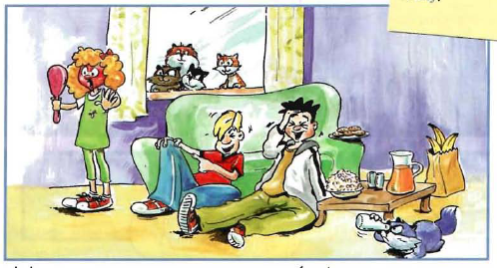
Banana - There are some bananas.
Milk - _________________________________________________
Biscuits - _______________________________________________
Orange juice - ____________________________________________
Cats - __________________________________________________
Mice - __________________________________________________
Apples - ________________________________________________
Popcorn - _______________________________________________
Dogs - _________________________________________________
Cherries - _______________________________________________
Task 2. Complete with some or any.
A: Are you hungry? There are 1) ________ cheese sandwiches in the fridge and
there are 2) _________ sausages on the table.
B: I want a sandwich, but I don’t want 3) __________ sausages.
A: Would you like 4) ___________ ketchup with your sandwich?
B: Sure.
A: Oops, we haven’t got 5) __________ ketchup.
B: That’s OK.
Task 3. Write a, an or some.



….cheese …..meat …. Orange …..bread …….coffee ……apple
Task 4. Fill the gaps with some or any.
- Is there___sugar on the shelf?
- We have not____coffee
- There are ___potatoes in the basket
- There are ___flowers in the vase.
- Would you like ___milk?
- Is there___tea in the cup?
- Is there___water in the bottle?
- Would you like ___cola?
Task 5. Look at the picture and write sentences as the example.
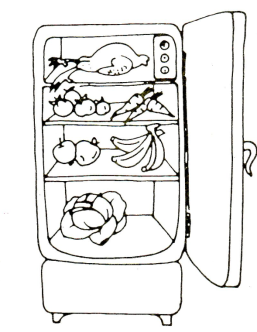
Apple? Are there any apples in the fridge? There are some apples in the fridge.
- Chicken? ____________________________________________________
- Cabbage? __________________________________________________
- Tomato? __________________________________________________
- Cucumber? ________________________________________________
- Carrot? ____________________________________________________
- Banana? ___________________________________________________
Task 6. Complete with some, any or a(n)
1. Have we got lemonade in the cupboard?
2. Look! There’s apple under the chair.
3. I’m hungry. I’d like sandwich, please.
4. There isn’t water in the fridge.
5. Would you like hot chocolate?
6. I’d like rice, please.
7. Let’s have hot dog after the concert.
Task 7. Listen and put tick or cross.
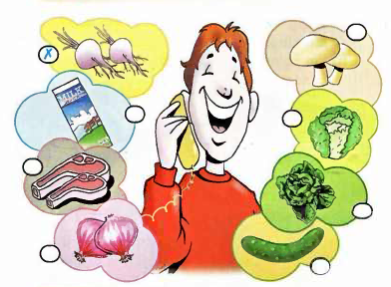
Turnips ___
Milk ___
Beef ___
Onions ___
Mushrooms ___
Lettuce ___
Cabbage ___
Cucumbers ___
Task 8. True or false.
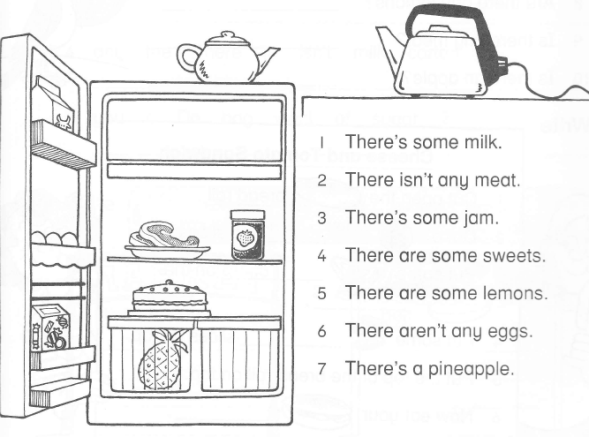
Test 2 (lesson 2)
- Complete the crossword.
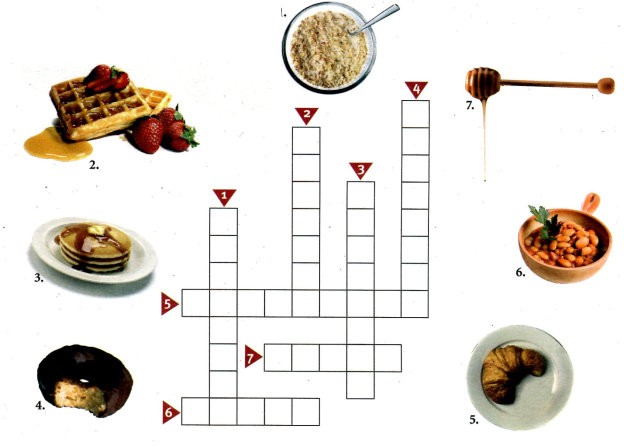
- Complete with some, any or a(n).
1. Have we got lemonade in the cupboard?
2. Look! There’s apple under the chair.
3. I’m hungry. I’d like sandwich, please.
4. There isn’t water in the fridge.
5. Would you like hot chocolate?
6. I’d like rice, please.
7. Let’s have hot dog after the concert.
- Cross out the odd word.
Rice tea milk coke
- Choose correct word.
I would like some …….. in my soup.
- Sugar
- Salt
- Water
- Pizza
- Complete with some, any or a.
- Would you like ______ hot dog.
- There aren’t ______ crisps in the packet.
- Get _______ packet from the supermarket.
- I’d like _______ rice with my chicken.
- Would you like ______ water?
- I’d like _____ for dinner.
- I don’t have ______ vegetables in the fridge.
- Match.
|
|
- Match
|
|
- Put the words in the correct order.
- Is b) any c) not d) there e) in f) fridge g) ice-cream h) the
- Complete the sentences. Use some or any.
1. There is …….. milk in the jug.
2. Do they sell ……… sugar-free sweets?
3. There aren’t ……….. apples on the table.
4. They haven’t got ………. money.
5. Are there ……….. vegetables in the fridge?
6. She drank ……..... tea.
- Correct the mistakes.
- There are any sandwiches in the fridge.
- Have we got some pasta?
- I would like some sandwich for lunch.
- No we haven’t any milks in the fridge.
- Choose right translation of proverb.
Better one small fish than an empty dish.
- Краще синиця у руках ніж журавель у небі.
- Маленька рибка краще пустої тарілки.
- Піймай маленьку рибу на пусту тарілку.
- Read the text .What did the tramp put in the soup?
STONE SOUP
One day a tramp came to an old woman’s house. “Excuse me”, said the tramp. “I’m very hungry. Can you give me anything to eat?” But the old woman was very mean. “Go away”, she said. ”I haven’t got any food”. “Oh”, said the tramp. “That’s a pity. I’ve got a magic stone. I can make soup with it. But I need some water”. “Well, I’ve got a lot of water”, said the old mean woman. She poured some water into a big saucepan. The tramp put it on the fire and put the stone into it. After a while he tasted the soup. “Mmm. That’s good. It just need a bit of salt and pepper”, he said. The old woman fetched some salt and pepper.
The tramp tasted the soup again. “That’s better”, he said. “It really needs a few
vegetables. It’s a pity you haven’t got any vegetables”. “Oh, I can find some”, the woman said. She ran to the garden and brought some potatoes, carrots, beets and a big onion. The tramp peeled and sliced the vegetables and put them into the saucepan.
“Is it ready?” asked the woman. “Almost”, answered the tramp. “It really needs a bit of meat”. “I can get some meat”, shouted the woman. She went to the kitchen and came back with a piece of ham and some sausages. The tramp chopped everything and put into the saucepan. Then he stirred the soup and said, “That’s OK. I can’t see the magic stone anymore. So the soup is ready. Bread is very good with stone soup. It’s a pity you haven’t got any bread”. “I have got some bread”, said the old woman. She went to the kitchen again and fetched some bread and butter.
Then the woman tasted the soup. “Mmm, this stone soup is delicious”, she said.
When the tramp left, he said, “Here is the magic stone. You can keep it. But remember, for the best stone soup you need a bit of meat, a few vegetables and a little salt and pepper”.
- Water
- Carrots
- Crisps
- Ham
- Butter
- Peanuts
- Sausages
- Salt
- Onions
- Beans
- Cheese
- Pepper
- Bread
- Potatoes
- milk


про публікацію авторської розробки
Додати розробку
